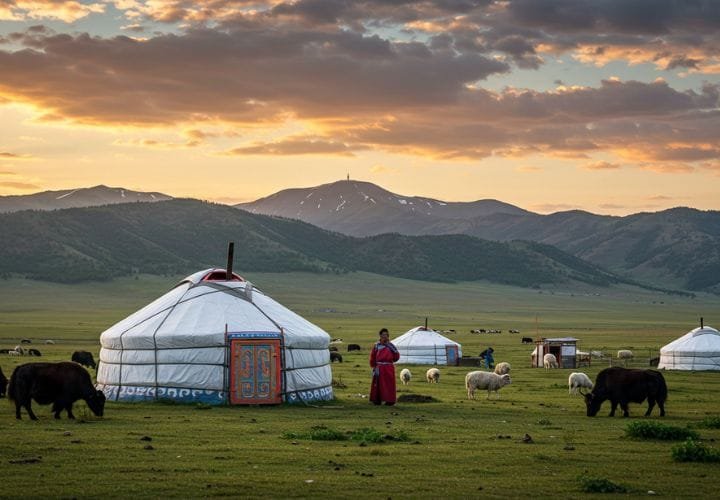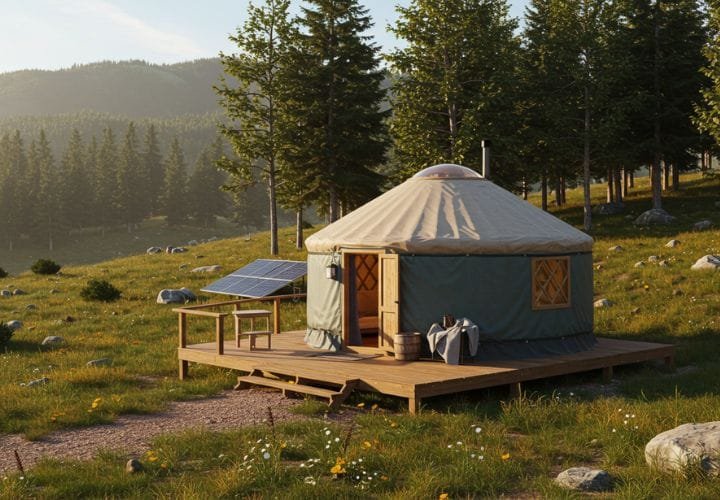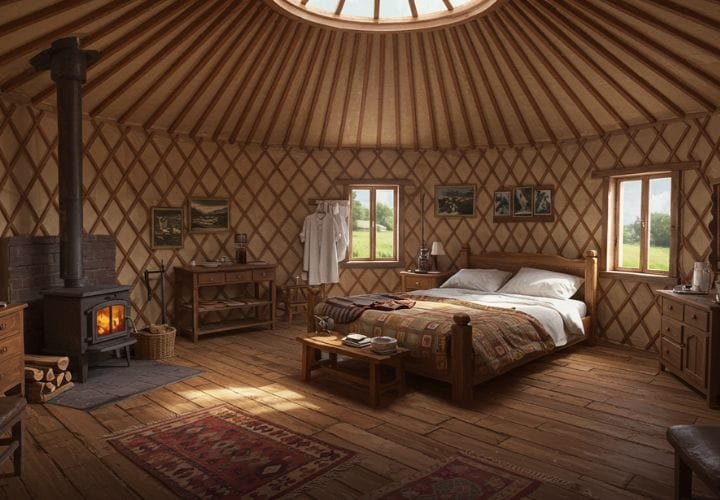Ever wonder why people are ditching regular homes for yurts? These round homes are perfect for off-grid living and sustainable living. But why do they stand out today?
Yurts were first used by nomads in Central Asia. Now, they’re back as a top choice for alternative housing. They’re cheap and eco-friendly. People like William Coperthwaite and companies like Pacific Yurts have made them popular in the U.S. They match today’s green and simple living trends.
Yurts stand out because they’re built with eco-friendly materials. They use updated materials that insulate well and are strong. This makes them good for the environment and your wallet.
Yurts are also really affordable. They cost way less to build and keep up than regular houses. They can be customized with things like kitchens and baths. Their round shape and big windows let you feel close to nature.
Introduction to Yurt Living

Yurt living is gaining fans around the globe. It mixes old-style charm with new-age materials. But what makes a yurt special? How did they become popular in modern times? We will explore what a yurt is, its history, and its use today.
What is a Yurt?
A yurt is a round tent known for its wood, felt, or fabric construction. It comes from Central Asia’s nomadic groups. Designed to be moved and sturdy, its frame is wood. It’s covered with felt and weatherproof fabric. Yurts are cozy and strong. They come in sizes like 20, 24, and 32 feet across. This means they can have 314 to 804 square feet of space.
Historical Background of Yurts
Yurts have a history over three thousand years long. They stem from Mongolia, Kyrgyzstan, and Kazakhstan. In Mongolia, called “gers,” they’re a major part of life. About 61% of Ulaanbaatar’s people live in them. Plus, 90% of the countryside does too. Yurts keep warm well, thanks to many felt layers. This design is why they’re still popular today.
Transition to Modern Usage
Though old designs are still loved, new materials have changed yurts. Now, they’re made with strong wood and fabrics that resist weather. This makes them more comfy and stable. Yurts can now stand up to harsh weather. So, people can live in them in many places.
Today’s yurts offer modern comforts like kitchens and bathrooms. They have heating and Wi-Fi too. Whether for living off-grid, adding something special to your land, or for a unique glamping experience, yurts mix old-world beauty with modern-day perks.
The Sustainability of Yurts

Yurts are becoming more popular for off-grid living. They’re known for being sustainable in their design and build. They use natural materials, are energy-efficient, and have a small ecological footprint. This makes yurts a great choice for eco-friendly living.
Eco-Friendly Materials
Sustainable materials like Douglas Fir wood are often used in yurts. This wood is strong and has a low impact on the environment. Rainier Outdoors uses this wood from the Northwest. Their yurts also use Penofin Verde, a green rosewood oil. This makes yurts a responsible living choice.
Energy Efficiency
Yurts are designed to save energy. Their round shape helps keep them warm in winter and cool in summer. Companies like The Out Factory add natural ventilation to boost this efficiency. Rainier Outdoors offers insulation options that reflect heat, based on NASA research. This keeps yurts comfortable all year.
cool in summer. Companies like The Out Factory add natural ventilation to boost this efficiency. Rainier Outdoors offers insulation options that reflect heat, based on NASA research. This keeps yurts comfortable all year.
Minimizing Ecological Footprint
Yurts have a smaller ecological footprint than regular homes. They use sustainable materials and focus on saving energy. Yurt owners often use solar panels, composting toilets, and rainwater systems. These features support a green lifestyle and help with water, waste, and power in remote areas.
In conclusion, yurts are an excellent option for eco-friendly living. They use green materials, save energy, and have a small ecological footprint. Yurts provide a complete approach to living in harmony with nature.
Affordability and Cost-Effectiveness
Yurts stand out as a cost-effective living solution. They offer affordable housing without sacrificing comfort or sustainability. Yurts have reduced initial construction costs compared to traditional housing. This makes them accessible to more people. They also have lower ongoing maintenance expenses, ensuring they remain affordable over time.
The energy-efficient design of yurts significantly reduces costs. They use natural insulation like wool, cutting down on heating and cooling needs. This saves on utility bills and supports eco-friendly living.
Modern advancements make yurts even more appealing. Features like solar panels and composting toilets can be added, further lowering costs and encouraging sustainability. These eco-friendly features make yurts a smart choice for affordable housing.
Here’s a comparison of the cost advantages of yurt living:
| Aspect | Yurt | Traditional House |
|---|---|---|
| Initial Construction Cost | Lower | Higher |
| Maintenance Expenses | Minimal | Significant |
| Energy Efficiency | High | Variable |
| Eco-Friendly Features | Often Included | Optional and Expensive |
| Mobility | High | Low |
Yurts are becoming more popular for permanent homes, glamping, and education. Their affordability and versatility make them great for those valuing financial and ecological sustainability.
Customization and Modern Amenities

Yurts are becoming popular because they are versatile and offer modern yurt amenities. With design flexibility, you can make the interior fit your style, from rustic to modern.
Design Flexibility
The ability to customize yurts stands out as a top feature. New materials and building methods let you design yurts for any taste. These round tents make great use of space. And their open design lets you set up living spaces just how you want.
You can mix modern touches, like electricity and plumbing, with classic styles to match your lifestyle.
Available Modern Amenities
Modern yurts impress with their modern yurt amenities. They can have full kitchens, bathrooms, and smart tech. These yurts use high-tech materials for better comfort and strength.
| Feature | Traditional Yurts | Modern Yurts |
|---|---|---|
| Materials | Wood and Felt | Engineered Wood, Steel, Weather-Resistant Fabrics |
| Amenities | Basic Furnishings | Kitchens, Bathrooms, Smart Home Technology |
| Layout | Simple and Open | Flexible Floor Plans |
| Energy Efficiency | Minimal Insulation | High Insulation, Energy-Efficient Systems |
Customizing yurts adds luxury and practicality. They’re eco-friendly too. The vast design flexibility lets you craft a space that’s truly yours.
Connection with Nature
Yurts are designed to make you feel connected to the outdoors. They have large windows and skylights. This lets you live in harmony with nature, improving your well-being.
Thanks to modern materials like engineered wood and weather-resistant fabrics, yurts are better than ever. They’re durable and blend with nature. Using wood and fabric, yurts are not only strong but also energy-efficient.
Yurts can have decks that let you enjoy the outdoors more. This makes it easy to live both inside and outside comfortably. Enjoying nature becomes part of your daily life. You get to enjoy:
- Expansive Views: The smart design of windows and skylights gives you amazing views. It brings a feeling of calm.

- Enhanced Airflow: Yurts are built to let air flow naturally. This reduces the need for air conditioning. It shows how energy-efficient designs are important.
- Sustainable Living: Yurts use natural materials and focus on being eco-friendly. They offer a lifestyle that saves money and protects the planet.
More people are choosing yurts as their homes. They are affordable, eco-friendly, and help you feel close to nature. Yurts are perfect for living or shared spaces. They blend the inside with the outside beautifully. Yurt living is becoming a popular way to be closer to nature.
| Benefits | Traditional Homes | Yurts |
|---|---|---|
| Cost | High initial and maintenance costs | Lower initial and ongoing maintenance costs |
| Material Usage | Varied, often non-sustainable | Sustainable materials like wood and fabric |
| Energy Efficiency | Dependent on design | Natural insulation and airflow |
| Connection with Nature | Limited by design | Seamless integration with natural surroundings |
| Portability | Generally immobile | Easy to assemble and disassemble |
Portability and Durability
Yurts are great for moving around and can last a long time. Originally from nomadic cultures, they’ve been updated for today’s use. They’re easy to move and can withstand many weather conditions.
Ease of Relocation
One big plus of yurts is how easy they are to put together and take apart. This makes them perfect for moving around, whether it’s for work or adventure. They offer the chance to change your scenery without hassle.
In times of emergency, yurts can be set up quickly to provide shelter. This makes them incredibly useful for disaster relief efforts.
Climate Resilience
Yurts can handle all sorts of weather, making them a strong choice for any place. Their shape helps save energy by keeping them warm in winter and cool in summer. They also use eco-friendly materials like wood and fabric for insulation.
This means your yurt is ready for any season or storm. It’s a smart choice for staying comfortable while being kind to the planet.
- Portable housing solutions benefit from easy assembly and disassembly.
- Durable living options are ensured with structural stability for various environments.
- Climate resilience is achieved through natural insulation and sustainable design.
| Aspect | Feature |
|---|---|
| Assembly Time | Quick and straightforward |
| Sustainability | Uses local and renewable materials |
| Energy Efficiency | Natural insulation, less artificial heating/cooling needed |
| Cost | More affordable than traditional housing |
| Relocation | Easy to dismantle and relocate |
| Comfort | Handles diverse climates effectively |
Eco-Friendly Yurt Homes: Benefits and Off-Grid Living Advantages
Yurts are becoming popular for people looking into off-grid and eco-friendly living. So, what is a yurt? They are unique homes with a circular shape and slight dome on top, used in Central Asia for thousands of years. Originally, nomads created them as a practical and mobile shelter.
The design of yurt homes has a flexible pole framework covered in fabric. This makes them both strong and easy to move. Their special build allows good airflow and stability, perfect for many different weather conditions. Lately, modern yurts are being chosen more often in the West. They are popular for camping and unique living spaces.
Yurts are also great for the environment. Most are made from materials that don’t harm the planet. Their round shape makes them withstand wind well. This means they can handle various weather situations.
People who like living off grid love yurts for their flexibility and low impact on the earth. They’re used as main homes, holiday getaways, or teaching areas. Yurts help people feel closer to nature while giving them comfort and practicality.
Conclusion
Yurts are becoming a popular choice for people who want to live differently. They blend old-world charm with modern needs, offering an affordable and eco-friendly home. Yurts invite us to live in harmony with nature without giving up our comforts.
Choosing a yurt means saving money both now and later. These homes are easy to move and strong, letting owners live in many places. They are also good for the planet because they use less energy for heating and cooling.
Creating communities around yurts is about more than unique homes. It’s about living with purpose and caring for the environment. Yurts are used for living in, learning, and even glamping. They show us a way to live with less impact on Earth while staying close to nature.
FAQ
What is a yurt?
A yurt is a round tent used by nomads in Central Asia. It is made from wood, felt, or fabric. Today’s yurts use modern materials for better durability and insulation.
Why are yurts gaining popularity for off-grid living?
Yurts are beloved for off-grid living because they’re both affordable and green. They use eco-friendly materials. This makes them great for reducing one’s environmental footprint.
How does the traditional yurt design benefit sustainable living?
The traditional yurt design values sustainable living. It uses materials like wood and wool. Its insulated shape is energy efficient. Modern versions may add solar panels and composting toilets.
Are yurts cost-effective solutions compared to traditional homes?
Yes, yurts cost less than traditional houses. The initial setup and upkeep are more affordable. Their design also cuts utility bills.
Can yurts be adapted with modern amenities?
Absolutely! Modern yurts can include kitchens, electricity, and plumbing. You can tailor them to your taste and needs.
How do yurts connect you with nature?
Yurts bring you closer to nature. They have large windows and skylights for sunlight and views. You can also have decks to enjoy the outdoors.
Are yurts portable and durable?
Yes, yurts are both portable and sturdy. They’re easy to move and set up. They’re made to endure all kinds of weather for year-round living.
How do modern yurt materials improve sustainability and comfort?
Modern yurt materials make them more sustainable and comfy. They offer better insulation and stability. This suits them to various climates, even in winter.
What are the benefits of living off the grid in a yurt?
Living off the grid in a yurt has many pluses. It lowers your environmental impact and costs. Plus, it supports a simple, sustainable way of life.
Source Links
- Yurt homes: A new circular living
- Off-Grid Living: How Yurts Offer Independence and Freedom
- What is a Yurt? Introduction, History, Benefits & Modern Uses | The Out Factory
- Create Off-Grid Living Spaces with Yurts
- Saving the Earth with Eco Yurts and Sustainable Practices
- Living Full-Time in a Yurt: A Journey Back to Simplicity – Secret Creek
- The Origins of Yurts, Tipis and other Portable Shelters



[…] Dome Houses Are Transforming Lives Dome houses are redefining sustainable living. These homes, part of InOurHands’ projects, offer unparalleled durability, being resistant to […]